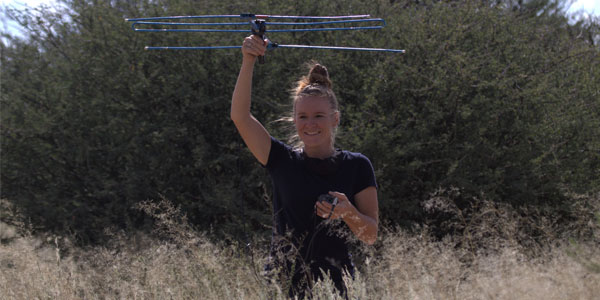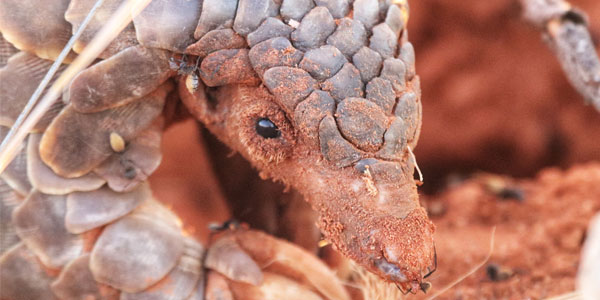
On ant(eater) patrol
- Leanne Rencken
PROFILE: Living to find innovative ways to solve tough challenges, Dr Wendy Panaino digs deep into the lives of pangolins.

We were discussing pangolins when Dr Wendy Panaino, a postdoctoral researcher in the School of Animal, Plant and Environmental Sciences (APES) explained: “Every decision an animal makes is based on whether it has the energy or not to do so.”
This quote struck me as pertinent, not just in the context of the pangolins she’s been researching for seven years, but in relation to Panaino as well. Her energy is incredibly dynamic, and this vibrancy comes across so clearly in our conversation, even though we’re chatting online.
With the pangolins, it’s the minutiae that fascinates her, and she’s in her element talking about these complex creatures – their physiology and how they function – although she’s not as expansive when it comes to figuring out the source of her own energy.
“Physically and physiologically, it shouldn’t make sense. I should not have the energy levels I have, given how little I sleep and what I eat,” she says with a huge smile.
“I think it’s life’s natural high,” she clarifies, and when you get to know her, even just a little, this makes so much sense.
Animal energy
Panaino's had to tap into this ‘natural high’ a lot over the years because of the demanding nature of her hyper-focused work with the elusive and endangered mammal.
As an ecology, environment, and conservation master’s candidate looking for a project to base her dissertation on, she stepped into a research programme looking to understand more about pangolins at Tswalu Kalahari Reserve in 2015, and she’s been there ever since.
Panaino upgraded her master’s to a PhD in 2017, continuing to pursue the pangolin project, as well as critical questions around climate change. She was awarded her PhD in 2021, and publishing her peer-reviewed work on pangolins in 2022, as well as a study on inter-species teamwork between Cape foxes and striped polecats in the southern Kalahari.
Her paper on pangolins asks if seasonal dietary shifts by Temminck’s pangolins compensate for winter resource scarcity in a semi-arid environment.
To answer the question, she literally spent days and nights – depending on the season, the rainfall, and other factors – tracking seven specific pangolins over a period of two years of field work.
If you’re wondering when she slept, the answer is she didn’t get much sleep at all. Pangolins are typically nocturnal so most of the research was done at night. This involved tracking them through the transmitters attached to their backs, going to great lengths to collect their faecal matter, and then much later, downloading information from the miniature temperature data loggers which were implanted and had to be removed to access the recordings.
Pangolin poop is Kalahari Gold
Describing the research process, she says: “In the evenings, I would pick a pangolin and go and wait outside the burrow, sitting as quietly as possible, barely breathing in the cold and the dark because they’re super shy. If there’s any disturbance, they won’t come out. You depend on your ears to know when they’ve emerged, and then you follow them around on foot.”
Sometimes this would be for a couple of hours, sometimes an entire night. As she explains, she was totally on their schedule, not just when they were foraging, but when they were pooping as well. The faecal matter she collected came to be known by the research crew as Kalahari Gold, because it was so valuable to the research, and so difficult to come by.
Over the study period, Panaino witnessed what coping strategies pangolins need to employ during a cold winter following a hot, dry summer season, as well as how they operate during a winter following an abnormally wet summer season, how these extremes affect the choices they make about diet, whether to move around at night, or unusually, during the day, and the impact this has on their body temperature and energy.
Balancing mammal-environment energy
As both a scientist and a problem-solver, Panaino believes whole-heartedly in the power of conservation. On the one hand, she admits that things are not looking good for pangolins, but on the other hand, she says: “There are ways for the environment to buffer the effect of climate change. If you have a completely denuded, overgrazed area, are animals in those areas likely to die quicker or sooner than in areas where things are healthier, more balanced, and where there’s lots of grass growth and insects? We still have a long way to go, but this is the kind of prediction we are moving towards: If you have a balanced, healthy ecosystem, things are likely to be more resilient, and there’s potential for the ecosystem to do better.”
After her PhD, Panaino has focused on work that encompasses entire ecosystems. She has been involved as a project manager with a climate change research initiative called KEEP (the Kalahari Endangered Ecosystem Project), an umbrella programme under the Tswalu Foundation that oversees several projects at Tswalu, looking at how different species behave and respond within the ecosystem.
While she is still affiliated to KEEP, she’s moved into a research consultancy role at Tswalu, about which she is very enthusiastic. Working with Professor Andrea Fuller in the Wits School of Physiology, Panaino recently appointed a master’s student to continue working with the pangolins, having designed a research study to look into the purpose of the pangolin. “We’ve never quantified their role,” Panaino says, “and it would be enormously beneficial to do so.”
A pangolin’s purpose
We know they are driven by their need for energy, and to reproduce, but Panaino still wants to find out what the purpose of the pangolin is within the environment. She wants answers to questions like how much soil they turn over in a year and what their impact is on insect colonies, but she’d also like to be able to do more to better inform law enforcement regarding the illegal pangolin trade.
“In court cases, a judge might ask what kind of punishment should be given to the perpetrators who are illegally trading animals. We want to be able to say, well, this is what role they play in the environment, and so removing them will have specific consequences. Hopefully this will allow court systems to improve their law enforcement and hand out more effective sentences.” she says.
“I like to have challenges, and to find innovative ways to solve them. Life happens and as a scientist you have to be open to adapt and evolve and develop. I actually don’t mind when things don’t go according to plan, it opens up room to change things and get creative. This is the exciting part!”
Pangolin Fact Box

As part of her PhD, Panaino calculated that each pangolin consumes around 5.6 million ants and termites per year. The study occurred during a particularly dry time, and with the rains during consecutive years, they ate even more. In conjunction with other ant-eating animals in the Kalahari (aardvarks and aardwolves, for example), pangolins play a huge role in regulating insect populations.
Pangolins do not actively seek free-standing water and meet their water needs from their prey.
Pangolins in the Kalahari are extremely fussy eaters, preying predominantly on two ant genera and one termite genus.
Although typically nocturnal, pangolins can shift their 24-hour activity to become diurnal under certain environmental conditions.
The pangolin navigation system is a total mystery – they forage throughout the night in zig zags, going from bush to bush. However, when it is time to go back to the burrow, they often go back in a straight line. Remarkably, this means they are not following a scent trail left behind that night.
Despite only walking on their two hind legs, pangolins can travel huge distances. One pangolin that was part of the Tswalu research study moved close to 40km – measured as a straight line within 10 days (although this was likely fewer days). Given that they don’t typically walk in straight lines, that total distance would have been much greater.
Pangolins are mostly covered in keratin scales and play host to various mite and tick species, demonstrating even more their value to the ecosystems.
In the Kalahari, pangolins tend to give birth to one pup per year in September. Elsewhere across their distribution, their breeding season does not seem to be so strictly defined.
Pangolin mothers never show their pups what to eat since they are rarely (if ever) seen foraging together. That means that the pup knows exactly which insects to go for purely by instinct.
- Leanne Rencken is a freelance writer.
- This article first appeared in Curiosity, a research magazine produced by Wits Communications and the Office of the Deputy Vice-Chancellor: Research and Innovation.
- Read more in the 15th issue, themed: #Energy. We explore energy research into finding solutions for SA's energy crisis, illuminate energy needs of people with disabilities, address the energy and digital divide in an unequal society, and investigate the origins of fire control.

